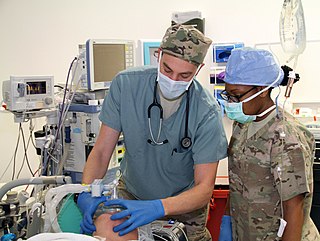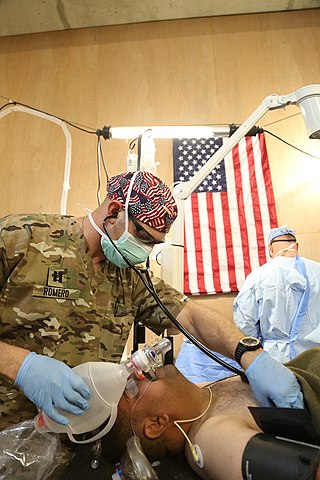Related Research Articles

A respiratory therapist is a specialized healthcare practitioner trained in critical care and cardio-pulmonary medicine in order to work therapeutically with people who have acute critical conditions, cardiac and pulmonary disease. Respiratory therapists graduate from a college or university with a degree in respiratory therapy and have passed a national board certifying examination. The NBRC is responsible for credentialing as a CRT, or RRT,

Anesthesia or anaesthesia is a state of controlled, temporary loss of sensation or awareness that is induced for medical or veterinary purposes. It may include some or all of analgesia, paralysis, amnesia, and unconsciousness. An individual under the effects of anesthetic drugs is referred to as being anesthetized.

Anesthesiology, anaesthesiology, or anaesthesia is the medical specialty concerned with the total perioperative care of patients before, during and after surgery. It encompasses anesthesia, intensive care medicine, critical emergency medicine, and pain medicine. A physician specialized in anesthesiology is called an anesthesiologist, anaesthesiologist, or anaesthetist, depending on the country. In some countries the terms are synonymous, while in other countries they refer to different positions and anesthetist is only used for non-physicians, such as nurse anesthetists.

A nurse anesthetist is an advanced practice nurse who administers anesthesia for surgery or other medical procedures. They are involved in the administration of anesthesia in a majority of countries, with varying levels of autonomy.

A Certified Registered Nurse Anesthetist (CRNA) is a type of advanced practice nurse who administers anesthesia in the United States. CRNAs account for approximately half of the anesthesia providers in the United States and are the main providers (80%) of anesthesia in rural America. Historically, nurse anesthetists have been providing anesthesia care to patients for over 150 years since the American Civil War and the CRNA credential came into existence in 1956. CRNA schools issue a doctorate of nursing anesthesia degree to nurses who have completed a program in anesthesia, which is roughly 3 years in length.

A surgical technologist, also called a scrub, scrub tech, surgical technician, or operating department practitioner or operating room technician, is an allied health professional working as a part of the team delivering surgical care. Surgical technologists are members of the surgical team. The members of the team include the surgeon, surgeon's assistant, circulator nurse and anesthesia provider. They possess knowledge and skills in sterile and aseptic techniques. There are few mandatory professional requirements for surgical technologists, and the scope of practice varies widely across countries and jurisdictions. Surgical technologists attend junior colleges and technical schools, and many are trained in military schools. In the military they perform the duties of both the circulator and the scrub. The goal is for surgical technologists to be able to anticipate the next move the surgeon is going to make in order to make the procedure as smooth and efficient as possible. They do this by having knowledge of hundreds of surgical procedures and the steps the surgeon needs to take in order to complete the procedure, including the very wide range of surgical instruments they may need. Specialties can include, but are not limited to, the following: genitourinary, obstetrics and gynaecology, urology, ENT, plastics, general, orthopedics, neurology, and cardiovascular. They only work in surgical or perioperative areas and are highly specialized. Surgical technologist is the proper term for a two-year program which earns a degree in applied sciences. The profession is up and coming and highly in demand.
An advanced practice nurse (APN) is a nurse with post-graduate education and training in nursing. Nurses practicing at this level may work in either a specialist or generalist capacity. APNs are prepared with advanced didactic and clinical education, knowledge, skills, and scope of practice in nursing.
The American Society of Anesthesiologists (ASA) is an educational, research and scientific association of physicians organized to raise the standards of the medical practice of anesthesiology and to improve patient care.
Nursing credentials and certifications are the various credentials and certifications that a person must have to practice nursing legally. Nurses' postnominal letters reflect their credentials—that is, their achievements in nursing education, licensure, certification, and fellowship. The letters usually appear in the following order:
Geriatric anesthesia is the branch of medicine that studies anesthesia approach in elderly.
The American Association of Nurse Anesthesiology (AANA), previously named the American Association of Nurse Anesthetists, is a professional association for nurse anesthetists in the United States. The organization states that it has a membership of more than 59,000. It organization represents approximately 90% of CRNAs in the United States. The AANA headquarters is currently located in Park Ridge, Illinois, a suburb of Chicago.
Perianesthesia nursing is a nursing specialty practice area concerned with providing nursing care to patients undergoing or recovering from anesthesia. Perianesthesia nursing encompasses several subspecialty practice areas and represents a diverse number of practice environments and skill sets.

A paraveterinary worker is a professional of veterinary medicine who performs procedures autonomously or semi-autonomously, as part of a veterinary assistance system. The job role varies throughout the world, and common titles include veterinary nurse, veterinary technician, and veterinary assistant, and variants with the prefix of "animal health".
Certified anesthesiologist assistants (CAAs) are highly trained master’s degree level non-physician anesthesia care providers. CAAs are integral members of the anesthesia care team as described by the American Society of Anesthesiologists (ASA). This designation must be disambiguated from the Certified Clinical Anesthesia Assistant (CCAA) designation conferred by the Canadian Society of Respiratory Therapists. All CAAs possess a baccalaureate degree, and complete an intensive didactic and clinical program at a postgraduate level. CAAs are trained in the delivery and maintenance of all types of anesthesia care as well as advanced patient monitoring techniques. The goal of CAA education is to guide the transformation of student applicants into competent clinicians.
The following outline is provided as an overview of and topical guide to anesthesia:
Advanced practice registered nurses (APRNs) are registered nurses with graduate degrees in nursing. APRN roles include: certified nurse midwife, clinical nurse specialist, certified registered nurse anesthetist, and nurse practitioner. APRNs assess, diagnose, manage patient medical problems, order diagnostic tests, and prescribe medications. Rules, regulations, and credentialing for APRNs vary by state. This page outlines the regulatory processes for nurse practitioners in Wisconsin, including education, certification, licensing, and credentialing. Regulatory and credentialing processes are continuously changing, and the information contained on this page is current as of November 2015.
Advanced Practice Registered Nurse (APRN) refers to a nurse with advanced education, typically at least a master's degree, and certification by a national certifying program. The APRN provides specialized and multifaceted care and are able to do 60 to 80 percent of preventative and primary care done by physicians. Minnesota Statutes section 148.171, subd. 3 states that in Minnesota, APRN "means an individual licensed as a registered nurse by the board, and certified by a national nurse certification organization acceptable to the board to practice as a clinical nurse specialist, nurse anesthetist, nurse midwife, or nurse practitionerr".
John Adriani was an American anesthesiologist and director of anesthesiology at Charity Hospital in New Orleans. He was president of the American Board of Anesthesiology (ABA) and he received a Distinguished Service Award from the American Society of Anesthesiologists (ASA). He was an early supporter of physician involvement in nurse anesthetist training.
Obstetric anesthesia or obstetric anesthesiology, also known as ob-gyn anesthesia or ob-gyn anesthesiology, is a sub-specialty of anesthesiology that provides peripartum pain relief (analgesia) for labor and anesthesia for cesarean deliveries ('C-sections').

James Tayloe Gwathmey, M.D. was an American physician and the first president of the American Association of Anesthetics. A pioneer of early anesthetic devices for medical use, he co-authored the first comprehensive textbook on the subject of medical anesthetics, titled Anesthesia, which was published in 1914. For this and other contributions to anesthesiology, which included innovations in administering anesthetics to war wounded and in obstetrics, Gwathmey was hailed at the time of his death as the "Father of Modern Anesthesia."
References
- ↑ "ASA Fast Facts: Anesthesiologists Provide Or Participate In 90 Percent Of All Annual Anesthetics". ASA. Archived from the original on 2007-02-02. Retrieved 2007-03-22.
- ↑ NBCRNA NCE http://www.nbcrna.com/certification/Pages/default.aspx. Retrieved 9 July 2016.
- ↑ AANA. "Certified Registered Nurse Anesthetists Fact Sheet".
- ↑ "The ASA Anesthesia Care Team statement" (PDF). American Society of Anesthesologists. October 13, 2013. Retrieved January 17, 2016.
- ↑ 175 Ky 416, 194 SW 375 (1917)
- ↑ 6 Cal 2d 402 (1936)
- ↑ "Chalmers-Francis v. Nelson - 6 Cal.2d 402 - Mon, 05/18/1936 | California Supreme Court Resources".
- ↑ "The Practice of Anesthesia (Position Statement)". American Association of Nurse Anesthetists. Archived from the original on 20 January 2016. Retrieved 17 January 2016.
- ↑ "The administration of anesthesia and the practice of medicine". AANA. 2006-02-01. Archived from the original on 2007-10-21. Retrieved 2007-02-10.